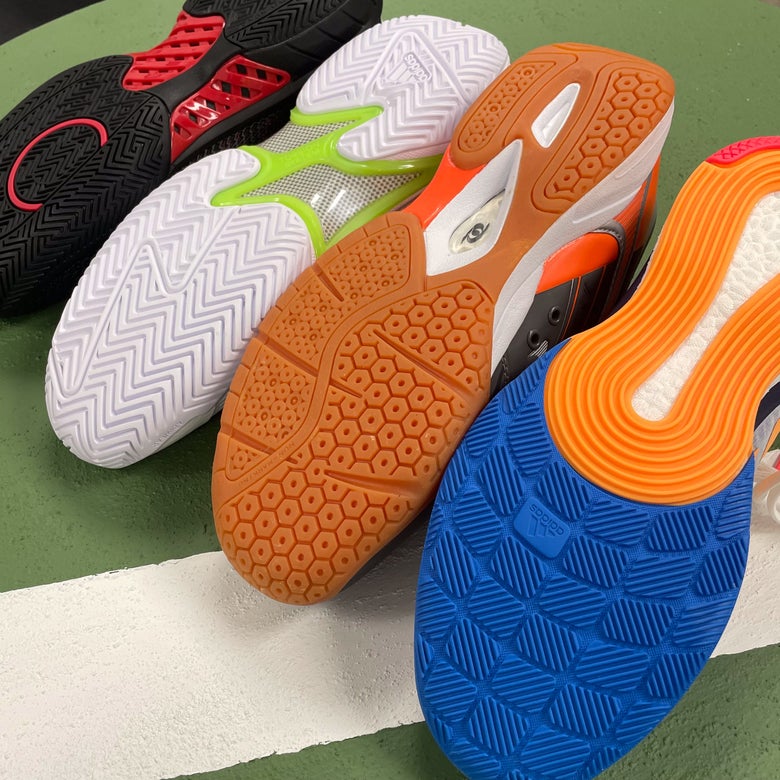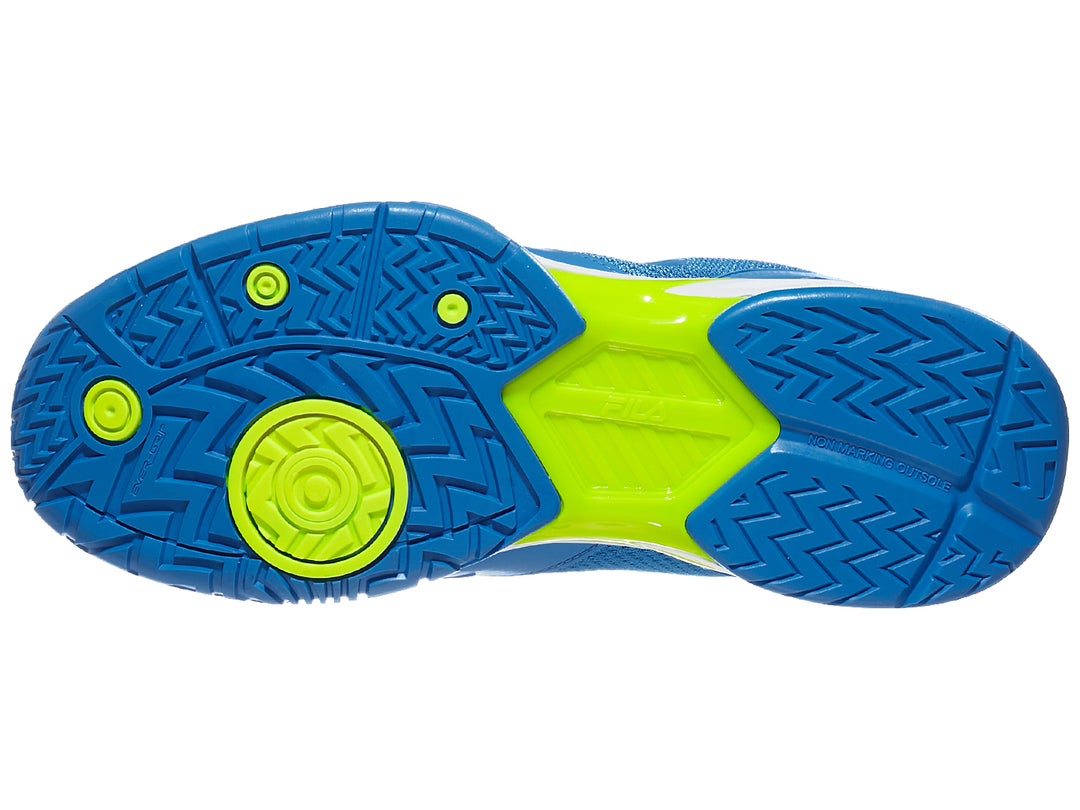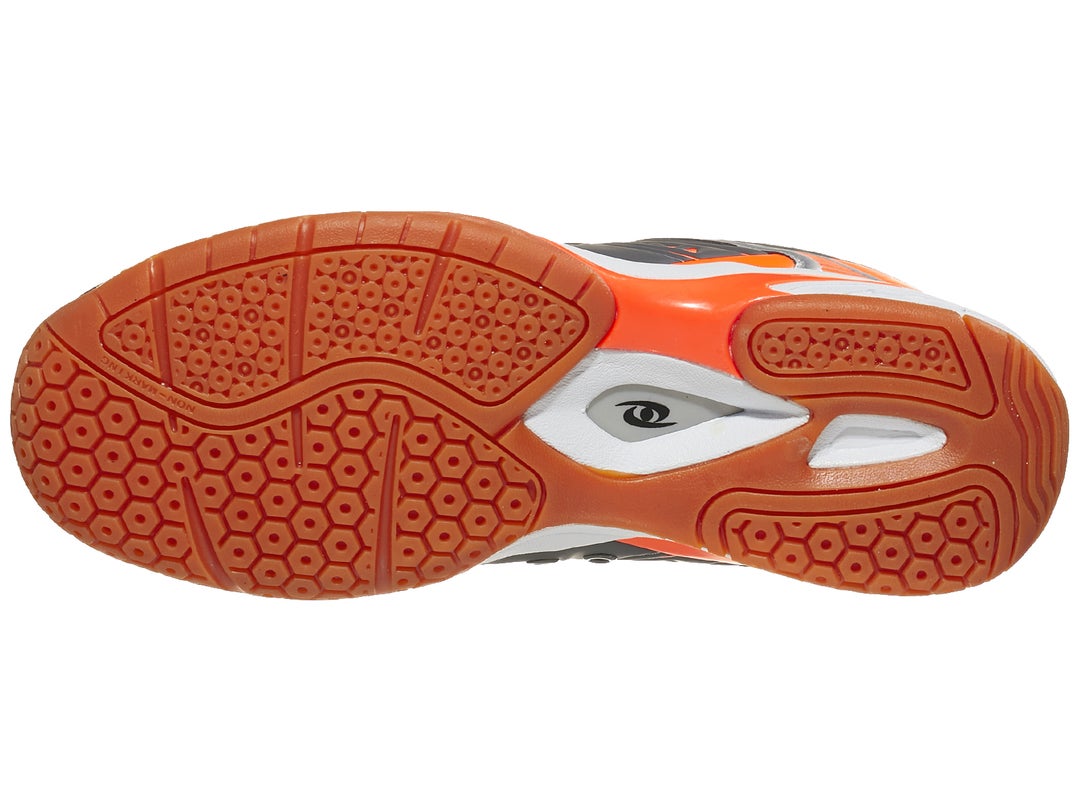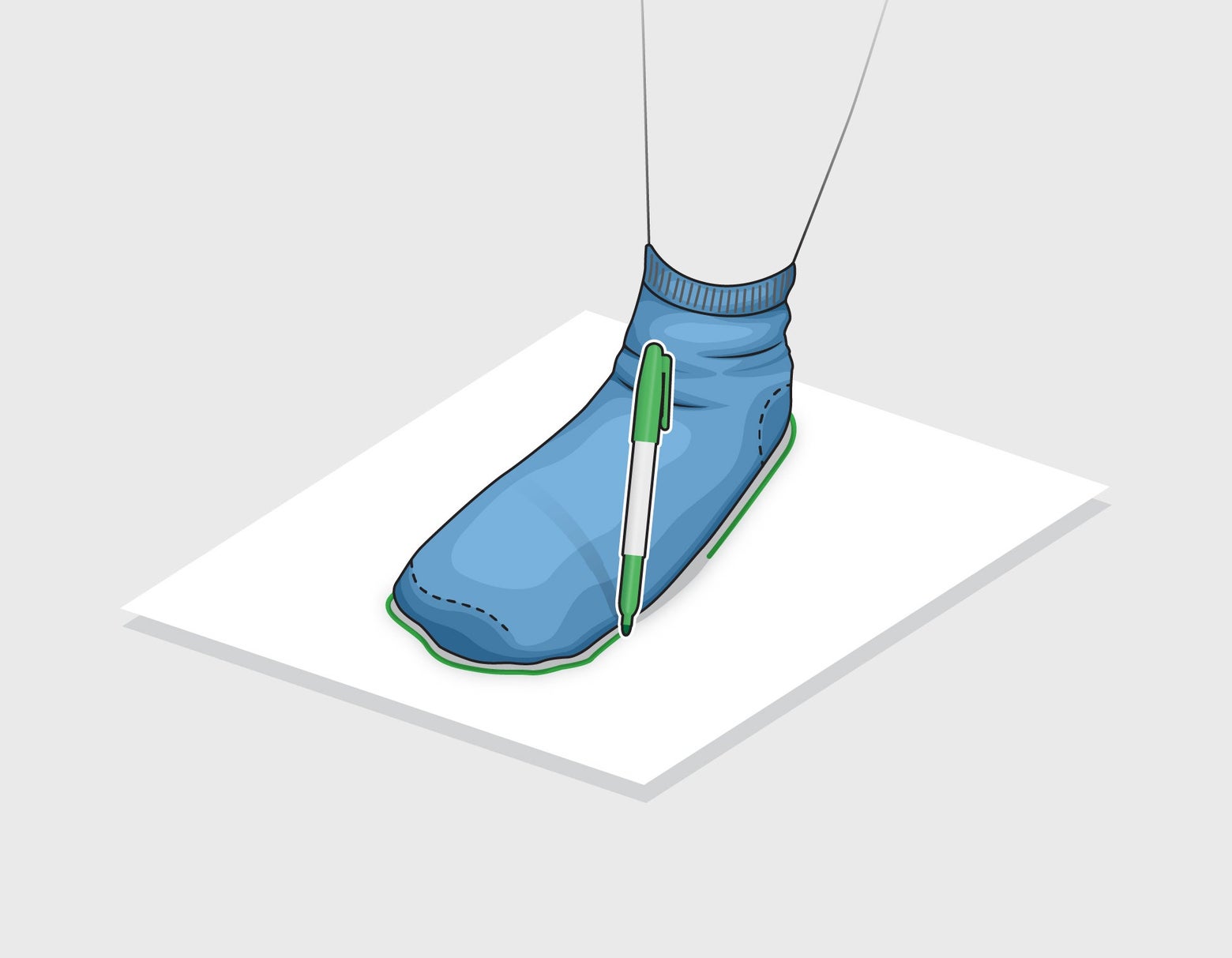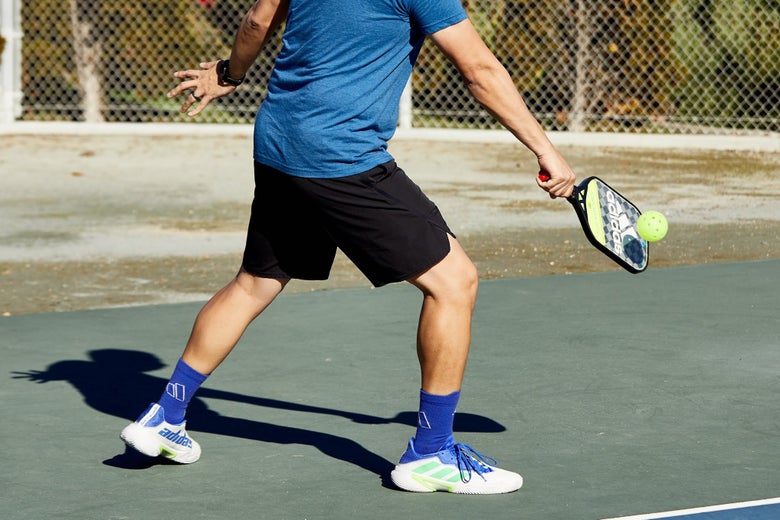How to Choose Your Next Pickleball Shoe
Pickleball requires making split second decisions and quick directional changes on the court. As a result, we advocate using an official pickleball court shoe over any other. Whether you're looking for your first pair of pickleball shoes or needing a replacement, there are 5 specific design elements that make a pickleball court shoe different from other types of shoes. Here's our guide on choosing a suitable pair of pickleball shoes. (Updated Dec. 2024)
Why Pickleball Shoes?
Pickleball is such a fun activity that many of us here can lose track of time, space and the score! And as fast as the sport of pickleball has progressed, we still notice many players chasing down shots wearing casual, cross-training or running shoes, none of which provide enough lateral support. Running or cross training shoes do share some of the same traits as a good court shoe, such as substantial midsole cushioning, but overall running shoes are constructed to best accommodate linear (heel-to-toe) forward movement rather than lateral. A good court shoe will feature 5 specific traits which make on-court directional changes safer and more comfortable.
What Constitutes a Good Pickleball Shoe
All shoes feature a medial and lateral side along with four sections from rear to front: The heel, midfoot, forefoot, and toe box area. That said, there are 5 main traits to look for when selecting an official shoe for pickleball:
1.) The upper: The shoe material(s) that wrap around and over the top of your feet are referred to as the upper. A good shoe for pickleball will feature a sturdy yet breathable upper which is a major source of a court shoe's lateral support in terms of holding your feet in place.
2.) Heel Counter: Or heel claw is a reinforced area of the rear of the shoe. The heel counter functions to provide foot support by preventing your feet from lifting up, or shifting side-to-side internally.
3.) Mid-foot Shank: Is typically made of a hard plastic, and located beneath the arch of your feet; either exposed or covered by the outsole material. The mid-foot shank is another primary source of foot support by preventing your feet from twisting and torquing in the shoe while changing directions on court. In addition, the location of the shank pushes the flex-point of the shoe out to where it should be, which is at the ball of your feet.
4.) Midsole: Often consisting of EVA and/or PU, the midsole of a pickleball shoe contributes to much of a shoe's comfort and cushioning. Overall thicker midsoles provide more comfort. And a pickleball shoe with a thinner midsole will make a shoe feel faster/easier to move in because your center of gravity is lower. The flip side to this is that if the midsole is extremely thick it can come at the expense of maneuverability because the midsole stack puts your feet higher off the court. And if there is not enough midsole material, there probably will not be sufficient cushioning either.
5.) Abrasion resistant outsole: Shoe manufacturers develop outsole rubber compounds and tread patterns which provide proper traction on a hard court surface, along with good outsole durability.
Indoor or Outdoor?
Although most pickleball is played on a hard court, whether there is a roof over the court or not, the sport is also played on wood laminate surfaces which are almost always indoors. Due to this fact it is important for the shoe to have an outsole specifically designed for the type of surface you’re playing on. Since outdoor (asphalt) and indoor (wood laminate) courts play differently, your game and footwork will also change slightly. For optimal performance and safety on each court surface, we emphasize wearing a pickleball shoe that is designed to handle the build of the court.
Outdoor Court Outsoles
The most common court surface is an asphalt hard court. This court type is more demanding on a shoe's outsole durability and are thus built to meet those demands. The outsole rubber compound of an outdoor shoe will be firmer for longevity purposes, compared to an indoor specific outsole, while still providing predictable traction to safely decelerate in to and accelerate out of your shots.
What happens if I use an outdoor pickleball shoe on an indoor court?
Ideally, one should play in a court shoe that is court surface specific. We do not advocate wearing outdoor court shoes on a wood laminate flooring because traction is less than ideal. If there is even a trace of water or sweat on this type of court, an outdoor shoe can feel like a skate and present risk for injury.
Indoor Court Outsoles
If you play most, or even some, of your pickleball on a wood laminate (gym floor) surface, an indoor court shoe is definitely the best option. An indoor pickleball shoe will feature a softer outsole rubber compound, sometimes referred to as "gum rubber", which provides both good traction on laminate flooring and also complements the midsole's level of cushioning.
These days most players are enjoying their pickleball, whether there is a roof overhead or not, on a hard court surface. Although there are indoor specific pickleball shoes available, hard court options far out number the indoor.
What happens if I use an indoor pickleball shoe on an outdoor court?
As already mentioned we recommend pairing the court shoe to the court surface. However, using an indoor shoe on an outdoor court will deliver good traction, but may result in the outsole wearing quickly, and depending on tread pattern, may even feel a bit too sticky.
Finding the Right Fit
Alright, now that you know which 5 aspects of shoe construction and design contribute to support, comfort, traction and longevity on a pickleball court we can move on to the all important choice of proper shoe length and width. To help write accurate shoe descriptions we try on all, and play in most of the shoes we feature on the site. This provides guidance in terms of what to expect from a particular shoe's length, width, arch support and overall feel.
How to Measure Your Foot
Step 1: Find a hard, flat surface and place a piece of paper on the floor.
Step 2: Wear socks that are similar to what you plan to wear when playing pickleball. Stand with one foot on the paper.
Step 3: Keeping your body weight over your foot, trace a thin line around the outside of your entire foot. When drawing the line, hold the pen perpendicular to the ground.
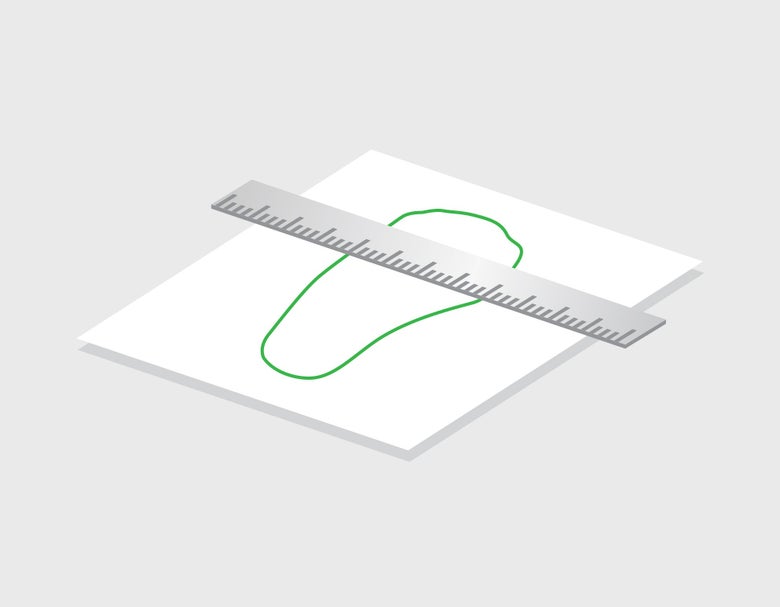

Step 4: Measure vertically down the length of your foot tracing. This is your foot length.
Step 5: Measure horizontally across the widest part of your foot tracing. This is your foot width.
Find your shoe size & width
Make sure you are looking in the proper column, either men's or women's, when determining your size. The standard width for women is B. The standard width for men is D.
*Note: This chart is here to give you a general idea on sizing and widths. Pickleball Warehouse is not responsible for mismeasurements or ordering the wrong size. We recommend that you order the size that you normally wear in other shoes.
Men's Shoe Sizing Chart
| Length of foot | US Size | Width | |||
| Inches | Centimeters | C | D (standard) | E | |
| 9 1/3 | 23.7 | 6 | 3.3" | 3.5" | 3.7" |
| 9 1/2 | 24.1 | 6.5 | 3.3" | 3.6" | 3.8" |
| 9 2/3 | 24.6 | 7 | 3.4" | 3.6" | 3.8" |
| 9 4/5 | 25 | 7.5 | 3.4" | 3.7" | 3.9" |
| 10 | 25.4 | 8 | 3.5" | 3.8" | 3.9" |
| 10 1/6 | 25.8 | 8.5 | 3.6" | 3.8" | 4.0" |
| 10 1/3 | 26.2 | 9 | 3.6" | 3.9" | 4.1" |
| 10 1/2 | 26.7 | 9.5 | 3.7" | 3.9" | 4.1" |
| 10 2/3 | 27.1 | 10 | 3.8" | 4.0" | 4.2" |
| 10 5/6 | 27.5 | 10.5 | 3.8" | 4.1" | 4.3" |
| 11 | 27.9 | 11 | 3.9" | 4.1" | 4.3" |
| 11 1/6 | 28.4 | 11.5 | 3.9" | 4.2" | 4.4" |
| 11 1/3 | 28.8 | 12 | 4.0" | 4.3" | 4.4" |
| 11 1/2 | 29.2 | 12.5 | 4.1" | 4.3" | 4.5" |
| 11 2/3 | 29.6 | 13 | 4.1" | 4.4" | 4.6" |
Women's Shoe Sizing Chart
| Length of foot | US Size | Width | |||
| Inches | Centimeters | A | B (standard) | C | |
| 8 1/2 | 21.6 | 5 | 2.6" | 2.8" | 3.0" |
| 8 2/3 | 22.0 | 5.5 | 2.7" | 2.9" | 3.1" |
| 8 5/6 | 22.4 | 6 | 2.8" | 2.9" | 3.1" |
| 9 | 22.9 | 6.5 | 2.8" | 3.0" | 3.2" |
| 9 1/16 | 23.3 | 7 | 2.9" | 3.1" | 3.3" |
| 9 1/3 | 23.7 | 7.5 | 2.9" | 3.1" | 3.3" |
| 9 1/2 | 24.1 | 8 | 3.0" | 3.2" | 3.4" |
| 9 2/3 | 24.6 | 8.5 | 3.1" | 3.3" | 3.4" |
| 9 5/16 | 25 | 9 | 3.1" | 3.3" | 3.5" |
| 10 | 25.4 | 9.5 | 3.2" | 3.4" | 3.6" |
| 10 1/6 | 25.8 | 10 | 3.3" | 3.4" | 3.6" |
| 10 1/3 | 26.2 | 10.5 | 3.3" | 3.5" | 3.7" |
Your Game Style
There are three primary traits of a court shoe: support, lightweight and comfort. And shoe manufacturers are always trying to strike a balance of all three. Realistically, you can expect to benefit from two of the traits, but to a degree, will come at the expense of the third. For instance, you can have a lightweight, comfortable court shoe if you concede some support. Another option is to go with a shoe that provides a high degree of support and comfort, but that shoe will have to weigh a little more. Lastly, you could make a shoe very supportive and lightweight, but some comfort would be sacrificed.
Support & stability: When it comes to foot support, we are talking about how capable the shoe is in terms of securing your feet in place. Shoe stability ties in the support the upper, heel counter and mid-foot shank provides, with how low the shoe's stance is to the court and how broad the shoe's footprint is. With all the lateral movements required in pickleball, support and stability are primary concerns as far as preventing an ankle roll or twist.
Lightweight (speed): We've learned from testing lots of court shoes over the years that the weight on the scale doesn't always tell the entire story of how light or heavy a pair of shoes will feel while playing. In addition to overall weight, a court shoe that features a thinner midsole will be lower to the court. That lower center of gravity makes it easier to accelerate and change directions on court, but may come at the expense of comfort over the long haul. Another caveat about light shoes is they are often not as durable. An easy way to make pickleball shoes lighter is to use less rubber on the outsole. This won't make as big a difference if you're playing on indoor courts, but players who frequent hard courts may notice that light shoes tend to wear out faster.
Comfort (upper and midsole): When it comes to pickleball footwear, and the fact that all of your weight is on your feet, it is important to wear court shoes that provide a high degree of comfort. If you are used to playing in running shoes or generic sneakers, the midsole of almost all official court shoes will feel, at first, a bit firmer underfoot. After a short break-in period the midsole typically softens up and you will get used to the benefit that a firmer ride provides. Another aspect of comfort, which also blends into the overall support of a shoe, are the materials used to construct the upper. A more spartan upper, tongue and lacing system will be more breathable and comfortable, but may not be as supportive relative to a court shoe made with a more substantial upper.
Additional questions to consider:
- Are you a player who tracks down shots with the exuberance of a Golden Retriever and/or wears through court shoes like a hot knife through butter?
- Is the potential for rolling the ankle such that you need a shoe that delivers lots of lateral stability?
- Do you have exceptionally wide or narrow feet?
- Do you have a higher or lower arch height?
- Are you frequently playing in hot tempratures?
The ideal pickleball shoe is the one that features those 5 important traits and also properly fits the feet and the needs of the individual in question.
